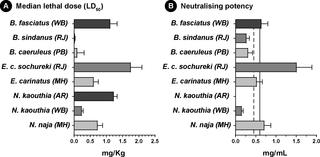当前位置:
X-MOL 学术
›
PLOS Negl. Trop. Dis.
›
论文详情
Our official English website, www.x-mol.net, welcomes your
feedback! (Note: you will need to create a separate account there.)
Beyond the 'big four': Venom profiling of the medically important yet neglected Indian snakes reveals disturbing antivenom deficiencies.
PLOS Neglected Tropical Diseases ( IF 3.4 ) Pub Date : 2019-12-05 , DOI: 10.1371/journal.pntd.0007899 R R Senji Laxme 1 , Suyog Khochare 1 , Hugo Francisco de Souza 1 , Bharat Ahuja 1 , Vivek Suranse 1 , Gerard Martin 2 , Romulus Whitaker 3 , Kartik Sunagar 1
PLOS Neglected Tropical Diseases ( IF 3.4 ) Pub Date : 2019-12-05 , DOI: 10.1371/journal.pntd.0007899 R R Senji Laxme 1 , Suyog Khochare 1 , Hugo Francisco de Souza 1 , Bharat Ahuja 1 , Vivek Suranse 1 , Gerard Martin 2 , Romulus Whitaker 3 , Kartik Sunagar 1
Affiliation

|
BACKGROUND
Snakebite in India causes the highest annual rates of death (46,000) and disability (140,000) than any other country. Antivenom is the mainstay treatment of snakebite, whose manufacturing protocols, in essence, have remained unchanged for over a century. In India, a polyvalent antivenom is produced for the treatment of envenomations from the so called 'big four' snakes: the spectacled cobra (Naja naja), common krait (Bungarus caeruleus), Russell's viper (Daboia russelii), and saw-scaled viper (Echis carinatus). In addition to the 'big four', India is abode to many other species of venomous snakes that have the potential to inflict severe clinical or, even, lethal envenomations in their human bite victims. Unfortunately, specific antivenoms are not produced against these species and, instead, the 'big four' antivenom is routinely used for the treatment.
METHODS
We characterized the venom compositions, biochemical and pharmacological activities and toxicity profiles (mouse model) of the major neglected yet medically important Indian snakes (E. c. sochureki, B. sindanus, B. fasciatus, and two populations of N. kaouthia) and their closest 'big four' congeners. By performing WHO recommended in vitro and in vivo preclinical assays, we evaluated the efficiencies of the commercially marketed Indian antivenoms in recognizing venoms and neutralizing envenomations by these neglected species.
FINDINGS
As a consequence of dissimilar ecologies and diet, the medically important snakes investigated exhibited dramatic inter- and intraspecific differences in their venom profiles. Currently marketed antivenoms were found to exhibit poor dose efficacy and venom recognition potential against the 'neglected many'. Premium Serums antivenom failed to neutralise bites from many of the neglected species and one of the 'big four' snakes (North Indian population of B. caeruleus).
CONCLUSIONS
This study unravels disturbing deficiencies in dose efficacy and neutralisation capabilities of the currently marketed Indian antivenoms, and emphasises the pressing need to develop region-specific snakebite therapy for the 'neglected many'.
中文翻译:

超越“四大”:对医学上重要但仍被忽视的印度蛇的毒液剖析揭示了令人不安的抗蛇毒血清缺陷。
背景技术印度的蛇咬致死率最高(46,000)和致残率(140,000)高于其他任何国家。Antivenom是蛇咬的主要治疗方法,其制造协议从本质上讲已经保持了一个多世纪。在印度,生产了一种多价抗蛇毒血清,用于治疗所谓的“四大蛇”的毒蛇毒:眼镜蛇眼镜蛇(Naja naja),普通,蛇(Bungarus caeruleus),罗素s蛇(Daboia russelii)和锯齿saw蛇(Echis carinatus)。除了“四大毒蛇”以外,印度还居住在许多其他种类的有毒蛇中,这些蛇有可能对其人类咬伤的受害者造成严重的临床甚至致命的毒害。不幸的是,没有针对这些物种产生具体的抗蛇毒血清,而是针对“四大” 抗蛇毒常被用于治疗。方法我们对主要被忽视但具有医学重要性的印度蛇(E. c。sochureki,B。sindanus,B。fasciatus和两个N. kaouthia种群)的毒液成分,生化和药理活性以及毒性特征(小鼠模型)进行了表征。及其最接近的“四大”同类产品。通过执行WHO建议的体外和体内临床前试验,我们评估了商业上销售的印度抗蛇毒血清在识别被这些被忽视物种的毒液和中和毒液方面的效率。结果由于生态和饮食的不同,所研究的具有医学重要性的蛇的毒液谱在种间和种内表现出显着差异。发现目前市售的抗蛇毒血清对“被忽视的许多人”显示出不良的剂量功效和毒液识别潜能。Premium Serums antivenom未能抵消许多被忽视物种和“四大”蛇(北印度蓝藻种群)之一的叮咬。结论本研究揭示了目前市场上出售的印度抗蛇毒血清在剂量功效和中和能力方面的令人不安的缺陷,并强调迫切需要为“被忽视的许多人”开发针对特定地区的蛇咬疗法。
更新日期:2019-12-06
中文翻译:

超越“四大”:对医学上重要但仍被忽视的印度蛇的毒液剖析揭示了令人不安的抗蛇毒血清缺陷。
背景技术印度的蛇咬致死率最高(46,000)和致残率(140,000)高于其他任何国家。Antivenom是蛇咬的主要治疗方法,其制造协议从本质上讲已经保持了一个多世纪。在印度,生产了一种多价抗蛇毒血清,用于治疗所谓的“四大蛇”的毒蛇毒:眼镜蛇眼镜蛇(Naja naja),普通,蛇(Bungarus caeruleus),罗素s蛇(Daboia russelii)和锯齿saw蛇(Echis carinatus)。除了“四大毒蛇”以外,印度还居住在许多其他种类的有毒蛇中,这些蛇有可能对其人类咬伤的受害者造成严重的临床甚至致命的毒害。不幸的是,没有针对这些物种产生具体的抗蛇毒血清,而是针对“四大” 抗蛇毒常被用于治疗。方法我们对主要被忽视但具有医学重要性的印度蛇(E. c。sochureki,B。sindanus,B。fasciatus和两个N. kaouthia种群)的毒液成分,生化和药理活性以及毒性特征(小鼠模型)进行了表征。及其最接近的“四大”同类产品。通过执行WHO建议的体外和体内临床前试验,我们评估了商业上销售的印度抗蛇毒血清在识别被这些被忽视物种的毒液和中和毒液方面的效率。结果由于生态和饮食的不同,所研究的具有医学重要性的蛇的毒液谱在种间和种内表现出显着差异。发现目前市售的抗蛇毒血清对“被忽视的许多人”显示出不良的剂量功效和毒液识别潜能。Premium Serums antivenom未能抵消许多被忽视物种和“四大”蛇(北印度蓝藻种群)之一的叮咬。结论本研究揭示了目前市场上出售的印度抗蛇毒血清在剂量功效和中和能力方面的令人不安的缺陷,并强调迫切需要为“被忽视的许多人”开发针对特定地区的蛇咬疗法。











































 京公网安备 11010802027423号
京公网安备 11010802027423号